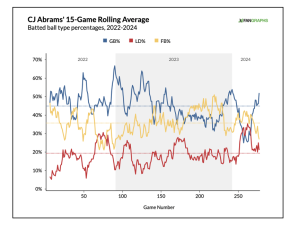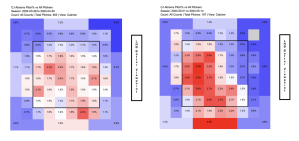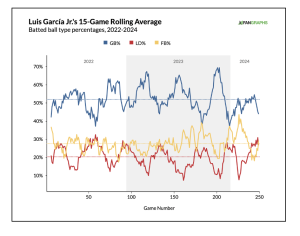Since trading Juan Soto to the San Diego Padres in one of the biggest trade deadline transactions in recent memory in 2022, the Washington Nationals have been embarking on a full-scale rebuild. While there have been some promising performances from some players such as Joey Meneses and Lane Thomas over the past couple of seasons, the popular narrative heading into the 2024 season was that the Nationals young core had produced much lower than expectations. This narrative has changed early this season with MacKenzie Gore taking the next step with an improved four seam-slider combo, James Wood producing very impressive AAA numbers on the precipice of a Major League call-up, and the further development of Dylan Crews and Brady House.
Every contending team aims to be strong “up the middle” of the field as the shortstop and second base positions require a mix offensive and defensive ability in order to provide positive value to a team’s overall performance. Given these factors, a particularly exciting development for Washington this season has been the offensive improvements of their middle infielders, with Luis García Jr. and CJ Abrams experiencing breakouts to start the 2024 season. While their defensive futures may be up in the air, García and Abrams are solidifying their roles as crucial members of the Washington Nationals‘ young core with impressive starts to the 2024 season.
Drafted out of high school by the San Diego Padres in the 1st round of the 2019 MLB Draft, Abrams was acquired by Washington as one of the centerpieces of the Juan Soto trade. Called up to the Major Leagues as a 21-year-old to play shortstop in Fernando Tatis Jr.’s absence, Abrams struggled throughout his first season of big league action, coupling an undisciplined approach at the plate with a tendency to frequently hit the ball on the ground. Over the past two seasons, Abrams has improved his approach and tapped into more of his power at the plate, raising his ceiling and solidifying his role as part of the Nationals young core moving forward.
Abrams has shown throughout his Major League career that he will not be a hitter known for elite plate discipline, as his walk rates have consistently been below league average. This is backed up by his O-Swing% which has hovered around 40% for his entire career and is currently at 43.7% this season. While it is always ideal for a hitter not to chase, Abrams has been able to minimize the downsides of this approach due to his above-average bat-to-ball ability, with a career 87.7% zone-contact rate and 72.2% out-of-zone contact rate. Perhaps this tendency to chase will cause Abrams headaches in the future, as out-of-zone contact rates tend to decline as players get older which will result in more swing-and-miss and a decline in offensive production.
While his approach at the plate has largely remained the same, Abrams has seen a large jump in offensive production this season with his wRC+ increasing from 90 to 137. This increase in production is driven by the increase in isolated power he’s produced this season (.167 to . 243), which stems from the physical development he has shown this season, improving his ability to hit the ball hard. With his hard hit rate increasing from 35.7% to 40.0% and his barrel rate increasing from 6.9% to 8.3%, Abrams has shown an ability to hit the ball harder this season and he has been making the most of the batted balls he has hit in the air, currently producing a 1.149 OPS (212 wRC+) on fly balls hit this season.

As shown by the rolling chart above, Abrams has consistently lowered his ground ball rate and raised his fly ball and line drive rate throughout his Major League career. Hitting the ball hard in the air is very good, and Abrams was able to pair hitting the ball in the ground less often with an increase in hard hit rate early in the season, which allowed for him to increase his barrel rate and raise his overall level of offensive production. While this change in batted ball profile allowed Abrams to get off to a hot start to the 2024 season, the sharp increase in ground ball rate at the rolling chart indicates to me that opposing pitchers might have adjusted to mitigate the amount of hard contact Abrams is able to produce.

As shown by the heat maps above, opposing pitchers pitched to Abrams throughout the strike zone during April and did not necessarily focus on attacking him with a specific location. Abrams was able to capitalize on pitches located on the inner third of the plate, as he was able to turn on these pitches resulting in more pulled fly balls and more power production. Pitchers have made a significant adjustment to facing Abrams in May, attacking him with pitches that are low-and-away. Given his aggressive approach and plus contact ability, Abrams will still be able to make contact on these pitches however this approach will likely lower Abrams’s ability to hit for power since low-and-away pitches are generally more difficult to turn on. This shift in approach has been successful so far at limiting Abrams’s ability to hit for power, as he has not been able to pull a fly ball during the month of May.
This raises the question, is an isolated power of .243 sustainable for Abrams? I would say that is not likely due to his aggressive approach at the plate and due to the aforementioned adjustments that pitchers have made to face him. It is possible that Abrams could make an adjustment to his approach at the plate and focus on pulling the ball in the air with the tradeoff of more swing-and-miss, however, given the Nationals apparent reluctance to have Abrams focus on hitting the ball in the air, I believe that this adjustment is unlikely to occur. While I do not believe that a .243 isolated power is sustainable for Abrams throughout a full season, the improved hard hit rate does provide optimism that more of Abrams’s balls hit into play will translate to extra-base hits which should allow for his isolated power to improve over his 2023 output. Overall, it appears that Abrams has finally grown into his offensive potential this season, and he projects to be an important piece of the Washington Nationals‘ blossoming young core moving forward.
Signed as an international free agent in 2016, Luis García Jr. was ranked as the top prospect in the Washington Nationals farm system when he made his Major League debut during the 2020 season. Similar to Abrams, García has been known for his aggressive approach at the plate which he’s been able to have some level of success with due to his plus bat-to-ball skills. With a tendency to also frequently hit ground balls in the past, García has shown an improved ability to hit the ball hard during the early part of the 2024 season which has fueled an increase in offensive production.
As shown by the table above, García has displayed a similar track record to Abrams over the past three seasons, displaying walk rates that are below league average due to an aggressive approach at the plate (career 38.1% O-Swing) and strikeout rates that are better than league-average due to plus bat-to-bat skills (career 10.7% swinging strike rate, 87.6% zone-contact rate). With a higher hard hit rate this season, García has been able to turn more of his batted balls into hits, and the increased barrel rates indicate that he is making efficient use of his hard contact by lifting his hard hit balls in the air, explaining the increase in his slash line from .266/.304/.385 (84 wRC+) last season to .286/.338/.437 (121 wRC+) this season.

As shown by the rolling graphs above, García has made a slight improvement in hitting the ball in the air more frequently which has allowed him to turn more of his hard hits into optimal offensive production (as evidenced by the increase in his barrel rate this season). While this improvement will help raise García’s offensive ceiling, his pull rate has declined this season to 31.9%. If he can make an adjustment that allows him to pull more fly balls, then García might have the potential to make a significant, sustainable improvement in his ability to hit for power.
García’s newfound ability to hit the ball hard can be incorporated into the trending discussion currently ongoing about Statcast’s new bat speed and bat tracking metrics. Introduced over the weekend, the public is now able to view various metrics that measure each player’s bat speed, swing length, and bat control ability. García’s swing length of 7.3 feet, below league average, is indicative of his plus bat-to-ball ability since a shorter swing appears to correlate with contact ability. While swing data from only 2024 is publically available, it would be interesting to see whether García increased his average bat speed from 2023, which could explain why he has seen an increase in hard hit rate so far this season. Overall, García has finally been able to combine some power with his plus bat-to-ball skills this season, and it appears that he has a chance to remain a constant in the Nationals starting lineup moving forward.
Concluding Thoughts
Displaying improvements in offensive production to start the season, Luis García Jr. and CJ Abrams are solidifying their roles as crucial members of the Washington Nationals‘ young core. While pitchers have adjusted to mitigate the amount of hard contact he produces, Abrams still projects to be a cornerstone piece of the Nationals rebuild while García has been able to add some power that, when combined with his plus bat-to-ball skills, allows for him to raise his level of offensive production.
The main issue with both of these players is their defensive outlooks, as both Abrams and García project to be second basemen long-term. Defensively, Abrams has played all 36 games at shortstop this season however I do wonder if this will be his long-term defensive home moving forward. Advanced defensive metrics rate him as a below-average defender at shortstop (-4 OAA, -3 DRS in 2024) and FanGraphs’s scouting report graded Abrams’s defense as a 35/45 when he was a prospect. Teams that are in contention tend to value a strong defensive player up the middle at shortstop and unless his defense dramatically improves, it appears that Abrams is destined to move to second base in the near future. García has played all 33 games at second base this season and advanced statistics indicate that he has been average to below-average at the position, with a 0 OAA and -3 DRS, aligning with his prospect evaluations that indicated that he would be an average defender at the position.
This leads the Nationals to a couple of options, either continue with Abrams at shortstop and hope he improves defensively, or sign a shortstop (Willy Adames?) in free agency and start either Abrams or García at second base. Given their recent extension talks, it appears that Abrams would be more likely to start at second in such a scenario, making García a potential trade candidate for teams that need a second baseman.
In conclusion, the Washington Nationals have appeared to turn the narrative of the rebuild around this season, with the improved offensive production of their blossoming middle infield combination being a major reason why the Nationals have reason to be optimistic about the future of their organization.
Photos by Icon Sports Wire and Adobe Stock | Adapted by Carlos Leano
